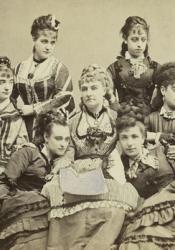Performance Venues of Lydia Thompson
Lydia Thompson's career in Burlesque Theater allowed her to travel from London all the way to New York. The map below shows Toole's Theater located at William IV Street in Westminster, London. This theater, later renamed the Folley Theatre by Thompson herself, staged several of Thompson's performances including various English adapted French operas and her most popular show, "A Husband in Cotton Wool." When Thompson and her troupe traveled to America in the late 1860's, they primarily performed at the Wood's Museum and Metropolitan located at 1221 Broadway (30th St.) New York, New York. At this location, they performed their most popular show, "Ixion, or The Man at The Wheel." This was the troupe's most popular show, and their most controversial. Thompson and her troupe returned to England after their finale of this show, but soon returned to Wood's Museum in 1886 following the death of Thompson's husband. These two locations were the most pivotal in Thompson and her troupe's careers.
EDIT: The map below would only allow one location to be entered. The location shown below is the Wood's Museum and Metropolitan located at 1221 Broadway (30th St.) New York, New York.
Works Cited:
Allen, R. (n.d.). Horrible Prettiness: Burlesque and American Culture (Cultural Studies of the United States).
Parent Map
Coordinates
Longitude: -74.005972800000

